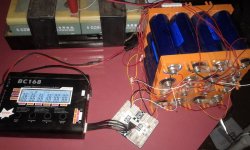Peter Brigg
10 W
- Joined
- Jan 13, 2012
- Messages
- 89
I have made a 12v battery using 8 Headway cells configured as 4 parallel units of 2 done up in series to get the 12v.
I also bought and installed a low voltage cutout to avoid over discharge.
It is boxed up and works well however the 2 pairs closest to 12v+ are now lower than the other 2 pairs and I am looking for a simpler way of charging these 2 low pairs.
My idea at the moment is to buy a 240v timer and set it on say 30 mins and then charge each of them in turn-I suppose I could charge 2 of them as a 6v unit.
I am using a small 12v battery charger-max current output switchable 3A or 6A
Sounds a bit clumsy however in the past I have seen how easy it is to get distracted and come back hours later to cooked cells.
Is there a problem with using a 12v charger to bring a single cell up to the others or is this a bit heavy duty?
Any ideas re balancing theses cells is appreciated.
Regards
Peter
I also bought and installed a low voltage cutout to avoid over discharge.
It is boxed up and works well however the 2 pairs closest to 12v+ are now lower than the other 2 pairs and I am looking for a simpler way of charging these 2 low pairs.
My idea at the moment is to buy a 240v timer and set it on say 30 mins and then charge each of them in turn-I suppose I could charge 2 of them as a 6v unit.
I am using a small 12v battery charger-max current output switchable 3A or 6A
Sounds a bit clumsy however in the past I have seen how easy it is to get distracted and come back hours later to cooked cells.
Is there a problem with using a 12v charger to bring a single cell up to the others or is this a bit heavy duty?
Any ideas re balancing theses cells is appreciated.
Regards
Peter


![DSC00205[1].JPG DSC00205[1].JPG](https://endless-sphere.com/sphere/data/attachments/112/112663-bed6f233f726cfd22e8068ad34613777.jpg)
![DSC00204[1].JPG DSC00204[1].JPG](https://endless-sphere.com/sphere/data/attachments/112/112664-6562d46998c75c10c53808cb47a4c61f.jpg)
![DSC00203[1].JPG DSC00203[1].JPG](https://endless-sphere.com/sphere/data/attachments/112/112665-486378cf45c5cacf16d45c68f32859fe.jpg)
